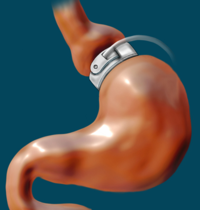
Photo from wikipedia
Purpose To investigate, in patients with gastric carcinoma undergoing laparoscopic radical gastrectomy, the effects of ultrasound-guided quadratus lumborum block (UG-QLB) combined with general anaesthesia (GA) on the postoperative recovery compared… Click to show full abstract
Purpose To investigate, in patients with gastric carcinoma undergoing laparoscopic radical gastrectomy, the effects of ultrasound-guided quadratus lumborum block (UG-QLB) combined with general anaesthesia (GA) on the postoperative recovery compared with GA alone. Patients and Methods The retrospective study enrolled 231 patients with gastric carcinoma undergoing laparoscopic radical gastrectomy, including 119 patients who received UG-QLB combined with GA (Group QG), and 112 patients undergoing GA alone (Group GA). The primary endpoint was the postoperative 3-year recurrence-free survival (RFS). The secondary endpoints were the average visual analogue scale (VAS) scores within 48 h after surgery, the first time of postoperative ambulation, the first time of flatus, postoperative hospitalization, perioperative opioid requirement and adverse effects after surgery. Results UG-QLB combined with GA did not affect the 3-year RFS in patients undergoing laparoscopic radical gastrectomy (HR 0.659, 95% CI 0.342–1.269, P=0.212). However, the VAS ranking analysis implicated that it could significantly alleviate the postoperative pain in laparoscopic radical gastrectomy patients (P<0.01). In addition, it dramatically facilitated the early recovery of postoperative ambulation and flatus, while shortening the duration of postoperative hospitalization (P<0.01). The most important was it could remarkably reduce the opioid consumption (P<0.01), which in the meanwhile, reduced the incidence of postoperative nausea and vomiting (PONV) (P=0.01). Conclusion Although UG-QLB combined with GA did not improve the 3-year RFS for patients with gastric carcinoma undergoing laparoscopic radical gastrectomy, it could provide satisfactory postoperative pain relief, reduce opioid consumption and adverse effects, which subsequently facilitates postoperative early rehabilitation.
Journal Title: International Journal of General Medicine
Year Published: 2022
Link to full text (if available)
Share on Social Media: Sign Up to like & get
recommendations!